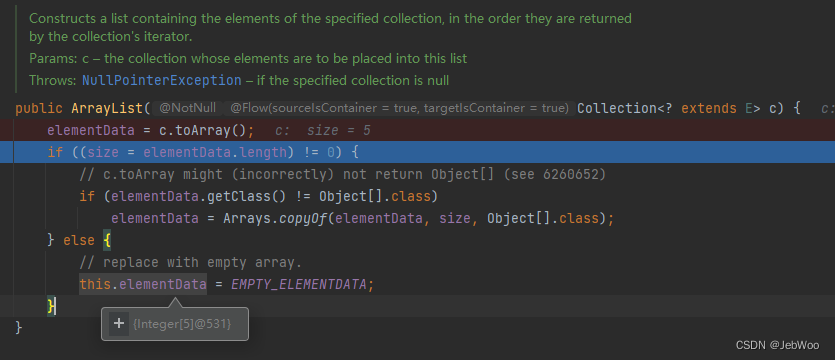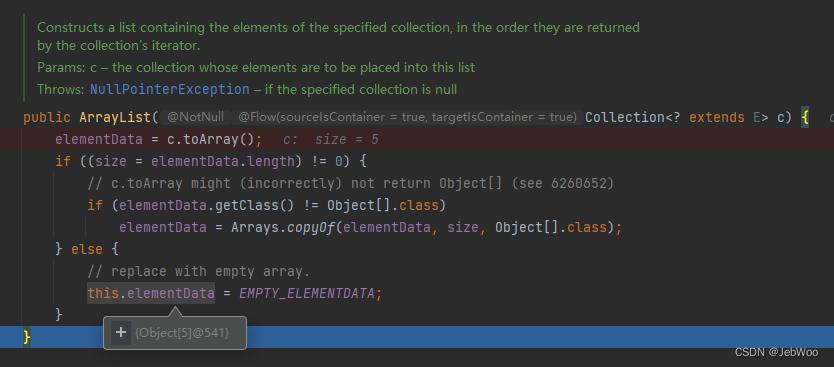1.ArrayList的UML图:

1.1.关于RandomAccess接口
ArrayList实现了RandomAccess接口,此接口为标记接口,表明实现此接口的List实现类具有随机访问特性。一些适用于随机访问列表的的算法应用与顺序访问列表时,可能会有不同的表现。如果一个算法在应用到随机访问列表的性能高于顺序访问列表时,建议检查此接口,并对算法做出相应调整以满足性能需求。
通常,如果循环A比循环B快的时候,就需要实现RandomAccess接口。
循环A:
for (int i=0, n=list.size(); i < n; i++)
list.get(i);
循环B:
for (Iterator i=list.iterator(); i.hasNext(); )
i.next();
2. ArrayList的内部实现:
2.1.数据存储:
ArrayList通过内部维护的一个数组transient Object[] elementData来存储数据。
/**
* The array buffer into which the elements of the ArrayList are stored.
* The capacity of the ArrayList is the length of this array buffer. Any
* empty ArrayList with elementData == DEFAULTCAPACITY_EMPTY_ELEMENTDATA
* will be expanded to DEFAULT_CAPACITY when the first element is added.
*/
transient Object[] elementData; // non-private to simplify nested class access
2.2.构造方法:
ArrayList有三个构造方法:
2.2.1. 无参构造方法
/**
* Default initial capacity.
*/
private static final int DEFAULT_CAPACITY = 10;
/**
* Shared empty array instance used for default sized empty instances. We
* distinguish this from EMPTY_ELEMENTDATA to know how much to inflate when
* first element is added.
*/
private static final Object[] DEFAULTCAPACITY_EMPTY_ELEMENTDATA = {};
/**
* Constructs an empty list with an initial capacity of ten.
*/
public ArrayList() {
this.elementData = DEFAULTCAPACITY_EMPTY_ELEMENTDATA;
}使用无参构造方法创建ArrayList时会使用DEFAULTCAPACITY_EMPTY_ELEMENTDATA创建一个空数组,但是此时ArrayList的容量使用的是默认容量10。
2.2.2. 带初始化容量参数的构造方法
/**
* Constructs an empty list with the specified initial capacity.
*
* @param initialCapacity the initial capacity of the list
* @throws IllegalArgumentException if the specified initial capacity
* is negative
*/
public ArrayList(int initialCapacity) {
if (initialCapacity > 0) {
this.elementData = new Object[initialCapacity];
} else if (initialCapacity == 0) {
this.elementData = EMPTY_ELEMENTDATA;
} else {
throw new IllegalArgumentException("Illegal Capacity: "+
initialCapacity);
}
}当初始化容量大于0时,会创建一个长度为initialCapacity的数组。
2.2.3. 入参为collection的构造方法
/**
* Constructs a list containing the elements of the specified
* collection, in the order they are returned by the collection's
* iterator.
*
* @param c the collection whose elements are to be placed into this list
* @throws NullPointerException if the specified collection is null
*/
public ArrayList(Collection<? extends E> c) {
elementData = c.toArray();
if ((size = elementData.length) != 0) {
// c.toArray might (incorrectly) not return Object[] (see 6260652)
if (elementData.getClass() != Object[].class)
elementData = Arrays.copyOf(elementData, size, Object[].class);
} else {
// replace with empty array.
this.elementData = EMPTY_ELEMENTDATA;
}
}将collection转换成数组后赋值给Object[] elementData。这里当collection长度不为0时,将原数组转换成Object[]。
通过调试可以看到,当传入长度为5的Integer列表时,首先elementData会被赋值为Integer[],如图

接着被修改为Object[],如图

2.3.关于容量:
ArrayList的add及addAll方法在添加元素时都会先调用ensureCapacityInternal方法来保证容量,add时ensureCapacityInternal传入参数即size + 1;addAll时传入参数即size+collection.size()。
private static int calculateCapacity(Object[] elementData, int minCapacity) {
// 通常使用无参构造方法生成的ArrayList的elementData长度是0
// 在添加第一个元素后,elementData大小经过扩容运算变成DEFAULT_CAPACITY=10
if (elementData == DEFAULTCAPACITY_EMPTY_ELEMENTDATA) {
return Math.max(DEFAULT_CAPACITY, minCapacity);
}
return minCapacity;
}
private void ensureCapacityInternal(int minCapacity) {
ensureExplicitCapacity(calculateCapacity(elementData, minCapacity));
}
private void ensureExplicitCapacity(int minCapacity) {
modCount++;
// 经过calculateCapacity计算后,若新的容量大于elementData的大小
// 则需要调用grow方法来扩充elementData的大小
// overflow-conscious code
if (minCapacity - elementData.length > 0)
grow(minCapacity);
}当添加元素时,elementData的容量达到上限时调用grow方法扩容,传入参数为存放数据所需的最小容量,默认为扩充为原大小的1.5倍。当所需最小容量大于这个1.5倍值的时候,将这个所需最小容量作为扩容后大小进行扩容。
/**
* The maximum size of array to allocate.
* Some VMs reserve some header words in an array.
* Attempts to allocate larger arrays may result in
* OutOfMemoryError: Requested array size exceeds VM limit
*/
private static final int MAX_ARRAY_SIZE = Integer.MAX_VALUE - 8;
/**
* Increases the capacity to ensure that it can hold at least the
* number of elements specified by the minimum capacity argument.
*
* @param minCapacity the desired minimum capacity
*/
private void grow(int minCapacity) {
// overflow-conscious code
// 原容量即elementData的大小
int oldCapacity = elementData.length;
// 扩容后的新容量,即原容量的1.5倍
int newCapacity = oldCapacity + (oldCapacity >> 1);
// 扩容后仍然无法满足所需的最小容量minCapacity,将minCapacity作为新的容量
if (newCapacity - minCapacity < 0)
newCapacity = minCapacity;
if (newCapacity - MAX_ARRAY_SIZE > 0)
newCapacity = hugeCapacity(minCapacity);
// minCapacity is usually close to size, so this is a win:
elementData = Arrays.copyOf(elementData, newCapacity);
}
private static int hugeCapacity(int minCapacity) {
if (minCapacity < 0) // overflow
throw new OutOfMemoryError();
return (minCapacity > MAX_ARRAY_SIZE) ?
Integer.MAX_VALUE :
MAX_ARRAY_SIZE;
}2.4.关于删除元素:
2.4.1. remove(int index)
将index+1至最后一个元素间长度为size - index - 1的元素copy到index处,并将最后一个元素置空
/**
* Removes the element at the specified position in this list.
* Shifts any subsequent elements to the left (subtracts one from their
* indices).
*
* @param index the index of the element to be removed
* @return the element that was removed from the list
* @throws IndexOutOfBoundsException {@inheritDoc}
*/
public E remove(int index) {
rangeCheck(index);
modCount++;
E oldValue = elementData(index);
// 需要移动的元素个数
int numMoved = size - index - 1;
if (numMoved > 0)
// index处之后的元素向前移动一个位置
System.arraycopy(elementData, index+1, elementData, index,
numMoved);
elementData[--size] = null; // clear to let GC do its work
return oldValue;
}2.3.1. remove(Object o)
遍历数组,找到需要删除的对象所在位置,然后使用与remove(int index)一样的方式移除元素
/**
* Removes the first occurrence of the specified element from this list,
* if it is present. If the list does not contain the element, it is
* unchanged. More formally, removes the element with the lowest index
* <tt>i</tt> such that
* <tt>(o==null ? get(i)==null : o.equals(get(i)))</tt>
* (if such an element exists). Returns <tt>true</tt> if this list
* contained the specified element (or equivalently, if this list
* changed as a result of the call).
*
* @param o element to be removed from this list, if present
* @return <tt>true</tt> if this list contained the specified element
*/
public boolean remove(Object o) {
if (o == null) {
for (int index = 0; index < size; index++)
if (elementData[index] == null) {
fastRemove(index);
return true;
}
} else {
for (int index = 0; index < size; index++)
if (o.equals(elementData[index])) {
fastRemove(index);
return true;
}
}
return false;
}2.3.3. removeAll(Collection<?> c)
使用了双指针的方式,在遍历一次的情况下移除Collection c中的所有元素,之后再finally中将多余的长度置空
/**
* Removes from this list all of its elements that are contained in the
* specified collection.
*
* @param c collection containing elements to be removed from this list
* @return {@code true} if this list changed as a result of the call
* @throws ClassCastException if the class of an element of this list
* is incompatible with the specified collection
* (<a href="Collection.html#optional-restrictions">optional</a>)
* @throws NullPointerException if this list contains a null element and the
* specified collection does not permit null elements
* (<a href="Collection.html#optional-restrictions">optional</a>),
* or if the specified collection is null
* @see Collection#contains(Object)
*/
public boolean removeAll(Collection<?> c) {
Objects.requireNonNull(c);
return batchRemove(c, false);
}
private boolean batchRemove(Collection<?> c, boolean complement) {
final Object[] elementData = this.elementData;
int r = 0, w = 0;
boolean modified = false;
try {
for (; r < size; r++)
// 若r处的元素在c中不存在
if (c.contains(elementData[r]) == complement)
// 将w处的元素写为elementData[r],且w后移一位
// 否则w指向的位置不变,仅r后移
elementData[w++] = elementData[r];
} finally {
// Preserve behavioral compatibility with AbstractCollection,
// even if c.contains() throws.
if (r != size) {
System.arraycopy(elementData, r,
elementData, w,
size - r);
w += size - r;
}
// 如果有移除元素,则此处w!=size为true,将w处之后的元素置空
if (w != size) {
// clear to let GC do its work
for (int i = w; i < size; i++)
elementData[i] = null;
modCount += size - w;
size = w;
modified = true;
}
}
return modified;
}2.3.4. retainAll(Collection<?> c)
删除所有Collection c中不包含的元素,即求与c的交集,删除算法参考removeAll。
/**
* Retains only the elements in this list that are contained in the
* specified collection. In other words, removes from this list all
* of its elements that are not contained in the specified collection.
*
* @param c collection containing elements to be retained in this list
* @return {@code true} if this list changed as a result of the call
* @throws ClassCastException if the class of an element of this list
* is incompatible with the specified collection
* (<a href="Collection.html#optional-restrictions">optional</a>)
* @throws NullPointerException if this list contains a null element and the
* specified collection does not permit null elements
* (<a href="Collection.html#optional-restrictions">optional</a>),
* or if the specified collection is null
* @see Collection#contains(Object)
*/
public boolean retainAll(Collection<?> c) {
Objects.requireNonNull(c);
return batchRemove(c, true);
}2.5. 关于trimToSize()
此方法用于将ArrayList的elementData的容量限制到size的大小,释放冗余的空间。
/**
* Trims the capacity of this <tt>ArrayList</tt> instance to be the
* list's current size. An application can use this operation to minimize
* the storage of an <tt>ArrayList</tt> instance.
*/
public void trimToSize() {
modCount++;
if (size < elementData.length) {
elementData = (size == 0)
? EMPTY_ELEMENTDATA
: Arrays.copyOf(elementData, size);
}
}























 被折叠的 条评论
为什么被折叠?
被折叠的 条评论
为什么被折叠?










